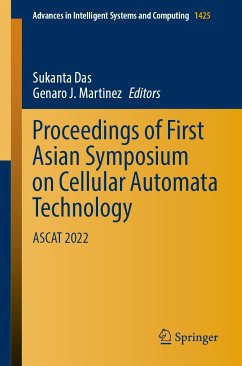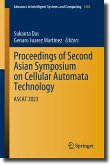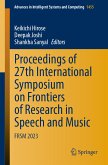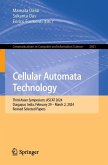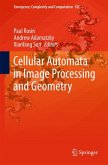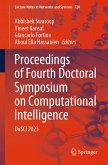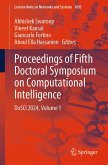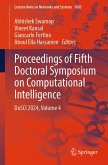Proceedings of First Asian Symposium on Cellular Automata Technology (eBook, PDF)
ASCAT 2022
Redaktion: Das, Sukanta; Martinez, Genaro J.


Alle Infos zum eBook verschenken

Proceedings of First Asian Symposium on Cellular Automata Technology (eBook, PDF)
ASCAT 2022
Redaktion: Das, Sukanta; Martinez, Genaro J.
- Format: PDF
- Merkliste
- Auf die Merkliste
- Bewerten Bewerten
- Teilen
- Produkt teilen
- Produkterinnerung
- Produkterinnerung

Hier können Sie sich einloggen

Bitte loggen Sie sich zunächst in Ihr Kundenkonto ein oder registrieren Sie sich bei bücher.de, um das eBook-Abo tolino select nutzen zu können.
This book gathers selected research papers presented at the First Asian Symposium on Cellular Automata Technology (ASCAT 2022), organized online by academicians from Kolkata, India, during March 3-5, 2022. The book presents one of the most emergent areas in natural computing, cellular automaton (CA). CA is a paradigm of uniform fine-grained parallel computation which has been explored to understand complex systems by developing its model at the microscopic level. The book discusses many real-life problems in the domain of very large-scale integration (VLSI) design and test, pattern recognition…mehr
- Geräte: PC
- ohne Kopierschutz
- eBook Hilfe
- Größe: 4.94MB
![Proceedings of Second Asian Symposium on Cellular Automata Technology (eBook, PDF) Proceedings of Second Asian Symposium on Cellular Automata Technology (eBook, PDF)]() Proceedings of Second Asian Symposium on Cellular Automata Technology (eBook, PDF)169,95 €
Proceedings of Second Asian Symposium on Cellular Automata Technology (eBook, PDF)169,95 €![Proceedings of 27th International Symposium on Frontiers of Research in Speech and Music (eBook, PDF) Proceedings of 27th International Symposium on Frontiers of Research in Speech and Music (eBook, PDF)]() Proceedings of 27th International Symposium on Frontiers of Research in Speech and Music (eBook, PDF)161,95 €
Proceedings of 27th International Symposium on Frontiers of Research in Speech and Music (eBook, PDF)161,95 €![Cellular Automata Technology (eBook, PDF) Cellular Automata Technology (eBook, PDF)]() Cellular Automata Technology (eBook, PDF)129,95 €
Cellular Automata Technology (eBook, PDF)129,95 €![Cellular Automata in Image Processing and Geometry (eBook, PDF) Cellular Automata in Image Processing and Geometry (eBook, PDF)]() Cellular Automata in Image Processing and Geometry (eBook, PDF)73,95 €
Cellular Automata in Image Processing and Geometry (eBook, PDF)73,95 €![Proceedings of Fourth Doctoral Symposium on Computational Intelligence (eBook, PDF) Proceedings of Fourth Doctoral Symposium on Computational Intelligence (eBook, PDF)]() Proceedings of Fourth Doctoral Symposium on Computational Intelligence (eBook, PDF)177,95 €
Proceedings of Fourth Doctoral Symposium on Computational Intelligence (eBook, PDF)177,95 €![Proceedings of Fifth Doctoral Symposium on Computational Intelligence (eBook, PDF) Proceedings of Fifth Doctoral Symposium on Computational Intelligence (eBook, PDF)]() Proceedings of Fifth Doctoral Symposium on Computational Intelligence (eBook, PDF)186,95 €
Proceedings of Fifth Doctoral Symposium on Computational Intelligence (eBook, PDF)186,95 €![Proceedings of Fifth Doctoral Symposium on Computational Intelligence (eBook, PDF) Proceedings of Fifth Doctoral Symposium on Computational Intelligence (eBook, PDF)]() Proceedings of Fifth Doctoral Symposium on Computational Intelligence (eBook, PDF)161,95 €
Proceedings of Fifth Doctoral Symposium on Computational Intelligence (eBook, PDF)161,95 €-
-
-
Dieser Download kann aus rechtlichen Gründen nur mit Rechnungsadresse in A, B, BG, CY, CZ, D, DK, EW, E, FIN, F, GR, HR, H, IRL, I, LT, L, LR, M, NL, PL, P, R, S, SLO, SK ausgeliefert werden.
- Produktdetails
- Verlag: Springer Nature Singapore
- Seitenzahl: 248
- Erscheinungstermin: 27. April 2022
- Englisch
- ISBN-13: 9789811905421
- Artikelnr.: 63911920
- Verlag: Springer Nature Singapore
- Seitenzahl: 248
- Erscheinungstermin: 27. April 2022
- Englisch
- ISBN-13: 9789811905421
- Artikelnr.: 63911920
- Herstellerkennzeichnung Die Herstellerinformationen sind derzeit nicht verfügbar.
